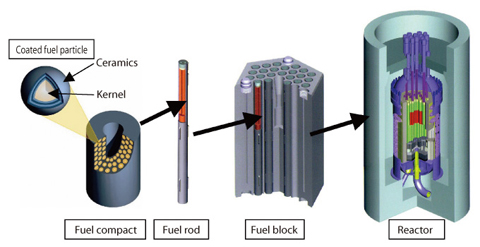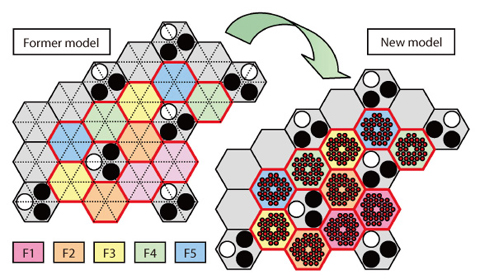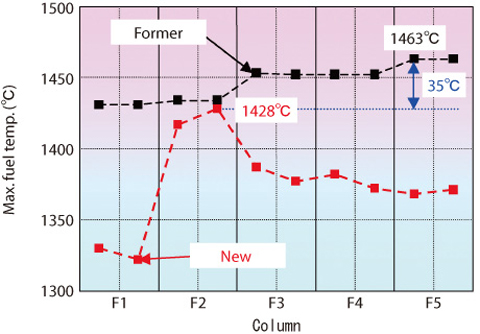
Fig.12-7 HTTR fuels

Fig.12-8 HTTR fuel temperature estimation model

Fig.12-9 Estimation result of fuel temperature
The High Temperature Gas-cooled Reactor (HTGR) is one of the next-generation reactors. It has inherent safety features, and enables multi-purpose heat utilization and high-efficiency power generation. The High Temperature Engineering Test Reactor ("HTTR") is the first HTGR in Japan constructed by us. In "HTTR" , the reactor outlet coolant temperature of 950°C was achieved on April 2004. Coated fuel particle (CFP) composed of a fuel kernel coated with 4 layers is used in "HTTR". To ensure the fuel integrity, the maximum fuel temperature should be kept below 1495°C in normal operation (Fig.12-7).
The maximum fuel temperature is estimated as about 1463°C in the current fuel temperature estimation. The various hot spot factors are considered to obtain conservative maximum fuel temperature in the former model. Realistic fuel temperature cannot be obtained. Also, a detailed fuel temperature distribution cannot be obtained.
Here, a representation model of each fuel rod (detailed model) is newly constructed to obtain a more realistic and detailed fuel temperature (Fig.12-8). In the former model, a fuel block is divided into 6 regions and the highest fuel temperature is estimated considering hot spot factors. In the new detailed model, each fuel pin is represented and its temperature can be estimated. All of the hot spot factors need not be considered in the new model because of representation of each fuel rod. The maximum fuel temperature is estimated as about 1428°C with the new model, which is about 35°C lower than the former model (Fig.12-9).
A realistic and detailed fuel temperature distribution can be estimated with the new model. It is expected that this model can contribute to improve the economy of HTGR, that is, the high-powered HTGR can be designed. In the future, more improvement of the model will be sought to obtain fuel temperature with high-accuracy.